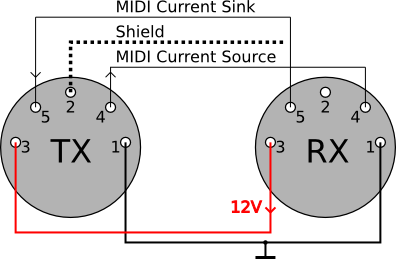Introduction
Purpose of this document is
- to provide the standard MIDI connector and cable pinout and also
- define electrical characteristics and a pinout power over MIDI.
This document uses key words defined in RFC 2119.
Terminology
Connection The logical connection between two sockets
Device A device that has at least one socket
Message A MIDI message such as note on or program change
Socket A single 5-pin MIDI connector build into an enclosure
Socket types
There are three different types of sockets:
MIDI In
A MIDI in or input is the receiving side of a connection where messages are intepreted. A MIDI input MUST implement galvanic isolation, i.e. by means of an opto-isolator.
MIDI Out
A MIDI out or output is the transmitting side of a connection. At this side messages are generated.
MIDI Thru
A thru socket also transmit messages, but without generating them. The origin of the messages is a second socket inside the same device.
Device classes
Transmitter
Transmitter devices (called TX) produce midi data.
Receiver
Receiving devices (aka RX) receive midi data.
Coupler
Coupler are both RX and TX in a single housing. They either MAY act as a
- repeater,
- merger or
- splitter device.
Connector Pin-Out
This is the pinout of a MIDI cable viewed from inside a housing of both a transceiver and a transmitter device or from outside the cable connectors:

Power over MIDI
All socket types MAY supply power over MIDI. If a socket delivers power, it MUST be labellel as described in Socket marking.
Powered sockets SHOULD supply 12V (+-1V) DC. Since MIDI system usually consist of a daisy-chain of coupler devices, it is omitted to specify a current source requirement.
Socket marking
All sockets SHOULD be labelled. Sockets that either deliver or use power over MIDI MUST be labelled. The label SHOULD consist of three lines:
- MIDI Data Flow
This line indicates the socket type and MUST either be IN, OUT or THRU. - MIDI Power Type
SHOULD be either SRC, SNK or FWD. SRC is the label for power source sockets, SNK indicates a power sink socket. The FWD label stands for "Forward". FWD is meant for sockets which passively forward power from a sink socket build into the same enclosure. - Current
For source devices: Maximum current available
For sink devices: Maximum current consumption
For forward devices: Maximum current consumption of the device, followed by a plus sign
 1.8.13
1.8.13